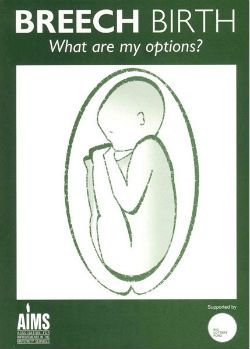
I wonder if breech births will be considered normal in ten or twenty years’ time, just as they were 20 years ago?
What is Normal?
 Most babies are born head down in the cephalic presentation. A few individualists, about 4%, decide that head up, bottom down, is best for them. It may be because of the shape of the uterus, the position of the placenta, the position of the cord, or simply that they haven’t got around to turning until there wasn’t much room to do it. It is presumptuous for us to think we know better than the baby the best position for birth. We are outside, it knows the situation inside.
Most babies are born head down in the cephalic presentation. A few individualists, about 4%, decide that head up, bottom down, is best for them. It may be because of the shape of the uterus, the position of the placenta, the position of the cord, or simply that they haven’t got around to turning until there wasn’t much room to do it. It is presumptuous for us to think we know better than the baby the best position for birth. We are outside, it knows the situation inside.
Most babies turn head down between about Week 30 and Week 36. Until that time there is plenty of room and they could be in any position. Some women are told at Week 31 or Week 32 that their baby is breech which is iniquitous. At that stage it is simply a baby that hasn’t turned yet. By about Week 35 you begin to think that this really is a breech baby.
Is Your Baby Really Breech?
The Hannah Trial
Until 2001 breech babies were born normally. In 2001 a report came out, The Hannah Trial, which suggested that it was safer for a breech baby to be born by caesarean. The methodology of this trial has subsequently been considered suspect and it only considered a caesarean and a breech delivery. A breech delivery means the woman was flat on her back with legs in stirrups. What the trial did NOT include was a normal breech birth with the woman on her hands and knees with a midwife present as shown in the attached photos. Subsequent research has shown this is the safest way for a breech baby to be born.
However, when The Hannah Trial came out, instantly all breech babies were born by caesarean and, though midwives are fully trained in assisting a woman to give birth to a breech baby vaginally, many of them have little opportunity to practice their skills. Because of all the research advocating normal birth, hospital policy is beginning to change. Many hospitals are encouraging normal birth for breech babies and are developing specialist teams of midwives to be available when a breech baby is born, and this trend is continuing.
Am I allowed to have a breech birth? What are my rights?
Some women are told they have to have a caesarean if the baby is breech. If ever you hear the words ‘allowed’ or ‘have to’ it’s the time to ask questions.
You are legally allowed to do whatever you like, and being sensible you want to find out the facts and carefully consider the advice of your midwife or obstetrician. Hospital protocols, national guidelines and evidence based care can sometimes be very different. Never be rushed into a decision. Always find out the facts first. Always make your decision out of knowledge and evidence rather than out of emotion. Remember it is YOUR decision, and these days more hospitals are supporting women in giving birth to their breech presenting babies normally. For example, St Thomas’ Hospital in London has set up a breech birth team so they can offer the best evidence based care to the mothers who give birth at the hospital.
Who can I talk to about having a breech birth?
 If your baby is breech and you would like to talk it through with someone, there are three places you can go to:
If your baby is breech and you would like to talk it through with someone, there are three places you can go to:
- Make an appointment with the supervisor of midwives or the consultant midwife at the hospital. She will give you more time than you have in your normal antenatal visit and will have more experience and seniority to sometimes be able to help you with a less choice. She will, however, be to an extent still be subjected to hospital protocols.
- Call the AIMS helpline on 0300 365 0663. This is a wonderful free resource to help anyone with a birth related question.
- Make an appointment with your nearest independent midwife who you can find on IMUK.org.uk . Independent midwives often have more experience than the NHS with breech babies as many women turn to them if it is difficult to find support in the NHS. After an hour’s appointment with an independent midwife you will be well informed and feel confident that whatever decision you make is the best choice for you.
How Can I Help My Breech Baby to Turn?
Sometimes your babies choice of position is in fact the right one for them. However I understand that there are certain presures in our society to have a head down presentation. With that in mind here are some options to help your baby turn:
1. External Cephalic Version
The hospital will offer an ECV (External Cephalic Version) to try to turn a breech baby. External because this is a manipulation that is done on the outside, Cephalic because it involves changing the position of the baby’s head, and Version because it is an attempt to turn the head downwards.
This is thought to be about 50% effective. Like every procedure it carries risks. The risk is that, in performing this forceful manoeuvre, the cord will be pulled, which will pull the placenta, which starts to detach and bleed. If this happens it is necessary to perform an immediate caesarean. That is why an ECV is not performed until Week 37 when the baby is concerned to have reached the average length of pregnancy.
Women who have trained in hypnobirthing have reported that using breathing and visualizations have helped keep them relaxed during this manipulation.
2. Acupuncture and Reflexology
There are other more gentle ways to encourage a breech baby to turn. Both acupuncture and reflexology are considered to be about 60% successful.
3. Talking To Your Baby
The most effective of all is hypnotherapy which is said to be about 80%. It may be difficult to accept that talking is more effective than ‘doing something’, but research shows this to be the case.
I have found that it is very effective if a mother simply talks to her baby herself. After all hypnotherapy is only words. She strokes her bump gently from the top, going down the left hand side to the bottom, at the same time gently talking to her baby, suggesting that it might like to turn, that it’s easy to turn, that many babies are easily born head down, that she acknowledges it could be in the very best position for him/her.
4. Spinning Babies
The Spinning Babies website describes a number of ways to help your breech baby turn head down.
Useful Resources
 | Breech Birth – What are my options?Author: Jane Evans One of the most experienced midwives in assisting women to give birth to their breech babies has written this informative and empowering book to inform women about the choices they have and help them decide what is right for them. |
 | Breach Baby AudioBy Katharine Graves Relaxation audio and suggestions for a head down presentation. |
Real Life Stories
 We want to encourage people to think differently about a breech presentation. You can still enjoy a natural birth. Here are some fabulous breech birth stories:
We want to encourage people to think differently about a breech presentation. You can still enjoy a natural birth. Here are some fabulous breech birth stories:
- Twins born naturally using hypnobirthing with the second baby arriving bum first!
- Breach baby says no to c-section – this baby had ideas of it own!
- Another breach baby birth story.
Further resouces available on our website:
- Rebozo – additional freedom of movement means that it is easier for the baby to move into a different position.
- Hypnotherapy succesfully helps to turn breach baby.
- Download our breech baby resource sheet here.
Credits and References
- The breech baby images shown on this page our courtesy of Karyn Loftesness Photography
- Lancet report on the Hannah Trial Dr Mary E Hannah 2000









